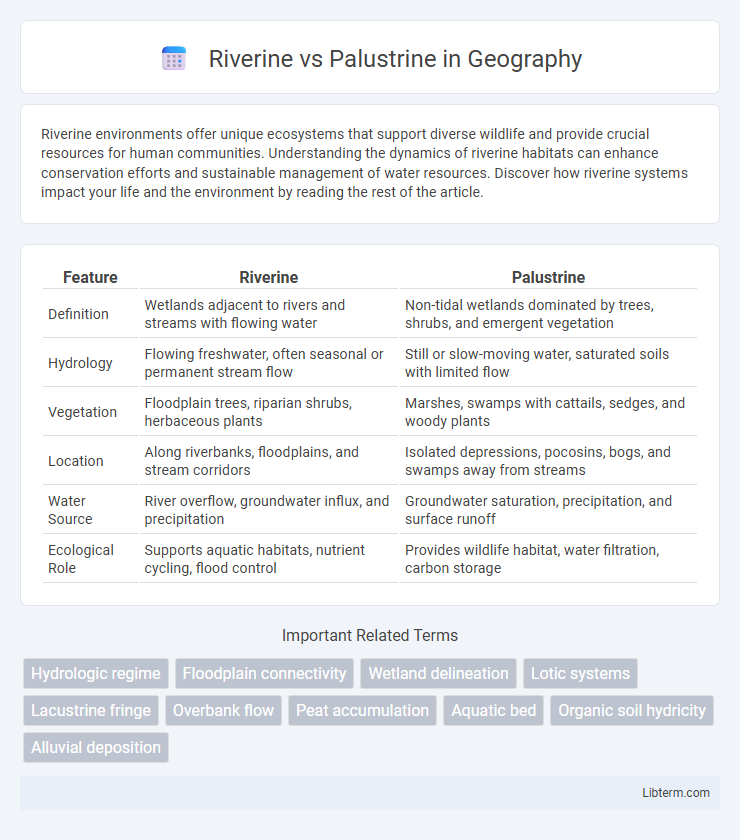Riverine environments offer unique ecosystems that support diverse wildlife and provide crucial resources for human communities. Understanding the dynamics of riverine habitats can enhance conservation efforts and sustainable management of water resources. Discover how riverine systems impact your life and the environment by reading the rest of the article.
Table of Comparison
| Feature | Riverine | Palustrine |
|---|---|---|
| Definition | Wetlands adjacent to rivers and streams with flowing water | Non-tidal wetlands dominated by trees, shrubs, and emergent vegetation |
| Hydrology | Flowing freshwater, often seasonal or permanent stream flow | Still or slow-moving water, saturated soils with limited flow |
| Vegetation | Floodplain trees, riparian shrubs, herbaceous plants | Marshes, swamps with cattails, sedges, and woody plants |
| Location | Along riverbanks, floodplains, and stream corridors | Isolated depressions, pocosins, bogs, and swamps away from streams |
| Water Source | River overflow, groundwater influx, and precipitation | Groundwater saturation, precipitation, and surface runoff |
| Ecological Role | Supports aquatic habitats, nutrient cycling, flood control | Provides wildlife habitat, water filtration, carbon storage |
Introduction to Riverine and Palustrine Systems
Riverine systems are freshwater environments characterized by flowing water in channels, such as rivers and streams, where hydrodynamics greatly influence sediment transport and ecosystem diversity. Palustrine systems consist of non-tidal wetlands dominated by persistent vegetation, typically found in marshes, swamps, and bogs, with slow or stagnant water conditions promoting unique plant and animal communities. Understanding the differences in water flow, vegetation, and habitat types is essential for wetland conservation, aquatic biodiversity, and ecosystem management.
Defining Riverine Wetlands
Riverine wetlands are defined by their location within river channels or floodplains where flowing water dominates the hydrology, supporting habitats adapted to current and periodic flooding. These wetlands play a crucial role in maintaining water quality, sediment transport, and providing habitat for diverse aquatic and terrestrial species. Unlike palustrine wetlands, which are primarily inland, freshwater, and non-tidal without flowing water, riverine wetlands are characterized by their connection to lotic systems and dynamic hydrological processes.
Characteristics of Palustrine Wetlands
Palustrine wetlands are non-tidal, inland wetlands characterized by the presence of freshwater, typically lacking significant flow like rivers or streams found in riverine systems. These wetlands support a diverse range of vegetation including trees, shrubs, and emergent plants such as cattails and sedges, which thrive in saturated soils and shallow water conditions. Palustrine wetlands play a critical role in water filtration, flood control, and providing habitat for amphibians, birds, and other wildlife, distinguishing them ecologically from the flowing water environments of riverine wetlands.
Key Differences Between Riverine and Palustrine Ecosystems
Riverine ecosystems are characterized by flowing freshwater habitats such as rivers and streams, with dynamic water movement influencing sediment transport and nutrient cycling. Palustrine ecosystems consist of non-flowing or slow-moving freshwater wetlands like marshes, swamps, and bogs, featuring dense vegetation and organic-rich soils that support high biodiversity. Key differences include hydrology, where riverine systems have continuous water flow compared to the stagnant or intermittent water in palustrine systems, and vegetation types, with riverine habitats typically supporting aquatic plants adapted to current and palustrine environments dominated by emergent, submerged, and floating vegetation.
Hydrological Dynamics and Water Sources
Riverine systems exhibit dynamic hydrological patterns driven by continuous flow from upstream sources, including precipitation, surface runoff, and groundwater influx, creating varied water velocity and volume fluctuations. Palustrine environments are characterized by more stagnant or slowly moving waters fed primarily by precipitation, groundwater seepage, and localized surface runoff, leading to stable water levels and saturated soils. Hydrological dynamics in riverine zones emphasize connectivity and transport of sediments and nutrients, whereas palustrine areas support water retention and nutrient cycling within isolated wetland complexes.
Biodiversity and Habitat Variations
Riverine ecosystems, characterized by flowing waters, support diverse aquatic species adapted to dynamic environments with varying currents and sediment loads. Palustrine wetlands, encompassing marshes, swamps, and bogs, provide critical habitats for a wide range of amphibians, birds, and plant species, thriving in stagnant or slow-moving waters rich in organic material. Biodiversity in riverine areas often centers on fish and macroinvertebrates, while palustrine zones sustain extensive vegetation and specialized fauna dependent on seasonal water fluctuations.
Ecological Functions and Services
Riverine ecosystems support dynamic hydrological processes, nutrient cycling, and habitat connectivity critical for fish migration and biodiversity maintenance. Palustrine systems, including wetlands and marshes, provide essential services such as water filtration, flood regulation, carbon sequestration, and wildlife habitat for amphibians and migratory birds. Both systems contribute significantly to landscape-level ecological resilience, with riverine areas promoting flow regulation and palustrine zones enhancing groundwater recharge and pollutant attenuation.
Human Impact on Riverine and Palustrine Areas
Human activities have significantly altered riverine and palustrine ecosystems through urbanization, agriculture, and industrial development. Riverine areas often face pollution from runoff, habitat fragmentation, and altered flow regimes due to damming, while palustrine wetlands experience drainage, land conversion, and nutrient loading that degrade water quality and biodiversity. Restoration efforts target nutrient management, invasive species control, and hydrological reconnection to mitigate these impacts on both ecosystem types.
Conservation Strategies and Management
Riverine and palustrine ecosystems require distinct conservation strategies due to their differing hydrological dynamics and biodiversity. Riverine conservation focuses on maintaining natural flow regimes, sediment transport, and connectivity to support aquatic species and prevent habitat fragmentation. Palustrine management emphasizes wetland restoration, water quality improvement, and protection from drainage and development to preserve crucial habitats for amphibians, birds, and plant diversity.
Conclusion: Importance of Wetland Classification
Wetland classification, such as distinguishing between riverine and palustrine systems, is crucial for effective environmental management and conservation strategies. Understanding the specific hydrological and ecological characteristics of riverine wetlands, which are associated with flowing waters, versus palustrine wetlands, typically dominated by non-flowing water and vegetation, ensures accurate assessment of biodiversity and ecosystem services. Precise classification supports targeted policy-making and habitat protection, enhancing wetland restoration and sustainable resource use.
Riverine Infographic

 libterm.com
libterm.com